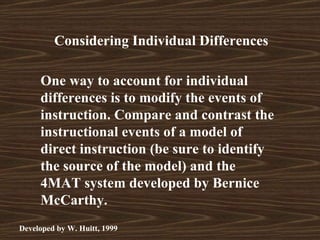4mat
•Transferir como PPT, PDF•
5 gostaram•2,130 visualizações
Denunciar
Compartilhar
Denunciar
Compartilhar

Recomendados
Mais conteúdo relacionado
Mais procurados
Mais procurados (20)
Learning theories, intellectual skills, cognitive skills, psychomotor skills

Learning theories, intellectual skills, cognitive skills, psychomotor skills
Conventional strategies and its Limitations in Teaching Science by Ms. Lourra...

Conventional strategies and its Limitations in Teaching Science by Ms. Lourra...
Semelhante a 4mat
Semelhante a 4mat (20)
Which type of Expert System – Rule Base, Fuzzy or Neural is Most Suited for E...

Which type of Expert System – Rule Base, Fuzzy or Neural is Most Suited for E...
Incremental learning from unbalanced data with concept class, concept drift a...

Incremental learning from unbalanced data with concept class, concept drift a...
Machine Learning an Exploratory Tool: Key Concepts

Machine Learning an Exploratory Tool: Key Concepts
Último
God is a creative God Gen 1:1. All that He created was “good”, could also be translated “beautiful”. God created man in His own image Gen 1:27. Maths helps us discover the beauty that God has created in His world and, in turn, create beautiful designs to serve and enrich the lives of others.
Explore beautiful and ugly buildings. Mathematics helps us create beautiful d...

Explore beautiful and ugly buildings. Mathematics helps us create beautiful d...christianmathematics
Último (20)
Seal of Good Local Governance (SGLG) 2024Final.pptx

Seal of Good Local Governance (SGLG) 2024Final.pptx
Explore beautiful and ugly buildings. Mathematics helps us create beautiful d...

Explore beautiful and ugly buildings. Mathematics helps us create beautiful d...
Food Chain and Food Web (Ecosystem) EVS, B. Pharmacy 1st Year, Sem-II

Food Chain and Food Web (Ecosystem) EVS, B. Pharmacy 1st Year, Sem-II
Unit-IV; Professional Sales Representative (PSR).pptx

Unit-IV; Professional Sales Representative (PSR).pptx
General Principles of Intellectual Property: Concepts of Intellectual Proper...

General Principles of Intellectual Property: Concepts of Intellectual Proper...
4mat
- 1. Considering Individual Differences One way to account for individual differences is to modify the events of instruction. Compare and contrast the instructional events of a model of direct instruction (be sure to identify the source of the model) and the 4MAT system developed by Bernice McCarthy. Developed by W. Huitt, 1999
- 2. Considering Individual Differences In general, there are three different approaches for dealing with individual differences among students: • Develop events of instruction that take into account individual differences • Provide some sort of grouping in order to reduce or accommodate the variability with respect to student background, achievement, ability or some other characteristic.
- 3. Considering Individual Differences In general, there are three different approaches for dealing with individual differences among students: • Modify the conditions within which instruction is taking place.
- 4. The 4MAT System The 4MAT system is a strategy for dealing with individual differences is to develop or modify the events of instruction so that they specifically address individual differences. It is a direct instruction approach to teaching that utilizes research on brain lateralization dominance and learning style to identify specific instructional events that will be attractive to a specific type of student.
- 5. The 4MAT System According to Bernice McCarthy, developer of the 4MAT system, there are 4 major learning styles, each of which asks different questions and displays different strengths during the learning process. These styles are based on the work of Gregorc & Butler (1984) and are similar to the temperaments as defined by the Myers-Briggs Type Indicator (MBTI) and the Kiersy Temperament Sorter. Gregorc, A., & Butler, K. (1984, April). Learning is a matter of style. VocEd, 27-29.
- 6. The 4MAT System Concrete-Random SP (Sensing/Perceiving) WHY? Sanquine
- 7. The 4MAT System Abstract-Sequential NJ (Intuitive/Judging) WHAT? Choleric
- 8. The 4MAT System Concrete-Sequential SJ (Sensing/Judging) HOW? Melancholy
- 9. The 4MAT System Abstract-Random NP (Intuitive/Perceiving) IF? Phlegmatic
- 10. The 4MAT System
- 11. The 4MAT System Each learning style is associated with both left- and right-brain learners. Left Right Logical, rational, Intuitive, sequential, serial, emotional, holistic, verbal parallel, and tactile-kinesthetic
- 12. The 4MAT System The 4MAT system is designed to provide every student with a preferred task during every lesson. There are the 8 instructional events proposed by this system.
- 13. The 4MAT System STEP LEFT MODE RIGHT MODE WHY? 1 Create an experience Reflect/Analyze 2 about experience
- 14. The 4MAT System STEP LEFT MODE RIGHT MODE WHAT? 3 Integrate into concepts Develop concepts 4 and skills
- 15. The 4MAT System STEP LEFT MODE RIGHT MODE HOW? 5 Practice defined givens Add something 6 of oneself
- 16. The 4MAT System STEP LEFT MODE RIGHT MODE IF? 7 Analyze application for relevance Add something 8 of oneself
- 17. The 4MAT System The 4MAT system seems to have considerable face validity, although there is not a widespread research base to support it. However, following the 4MAT system forces the teacher to provide her students with opportunities to engage in higher-order thinking.
